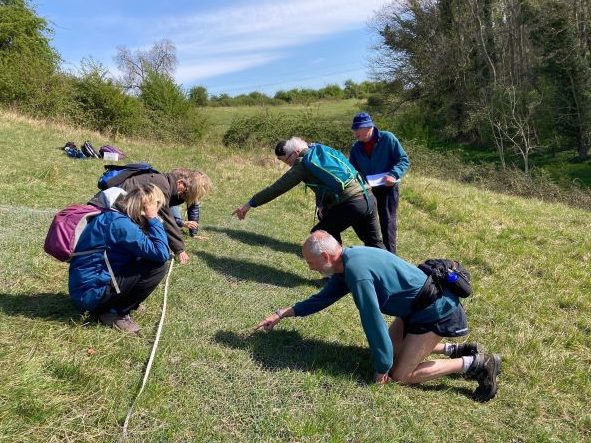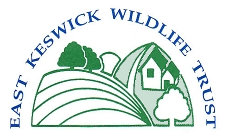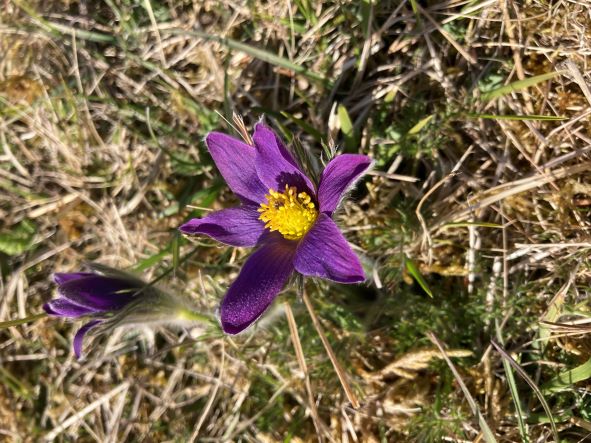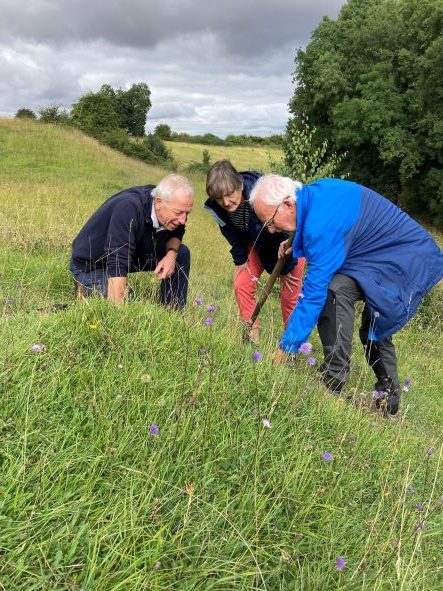Geoffrey Grigson in ‘The English Mans Flora’ (1955) said about the Pasque flower; ‘it has a fair claim to being the most dramatically and exotically beautiful of all English plants’.
Over recent decades this small, iconic native plant has raised concern in conservation circles due to its rapid decline and disappearance across much of its former range in the UK. Once widespread and common it is now a very rare plant and of conservation concern. Over 99% of its population is found on just five sites in the UK, with a small number of other sites holding only tiny, threatened populations. The plant is long lived, small and can be inconspicuous, except when it flowers in early spring around Easter time, hence the name given to it of Pasque flower, Pulsatilla vulgaris. It was thought lost as a Yorkshire plant until in 1984 a single plant was discovered in a heavily grazed limestone grassland near Leeds, now it’s most northerly UK site. It is thought the plant had not been seen sooner as any flower buds may have been grazed off by sheep or rabbits.
From that point onwards Natural England’s predecessor, English Nature, took over the lease of the site to implement good conservation management. During the 1980s some work to increase the population was done by biologists at Bradford University. This work was unsuccessful and the viability of the plant’s single seed was questioned. In the early 2000s Leeds City Council Conservation Department wrote and published a Biodiversity Action Plan for the Leeds District and the Pasque flower was identified as a priority species for conservation action. Some early work was instigated by Leeds City Council, but interest and effort ceased and the planned aspirations for the plant came to nothing along with those of several other species and habitats of concern that had been targeted by the plan.
By 2016 the status of the Pasque flower in Yorkshire was unclear. A few local amateur and professional botanists were aware that at least one plant was still at this site with reports of possibly two or three further plants. Aside from good management of the site by the Yorkshire Wildlife Trust, nothing was in place to secure its long term future in Yorkshire. This was until a senior officer from Natural England, knowing of East Keswick Wildlife Trust’s successful conservation projects and our developing expertise and success in germinating uncommon native wild plant seed, approached us and suggested we take on the project to help save this plant from possible extinction in Yorkshire.
Two seeds had been taken from the one mature Yorkshire plant in 2015 and we proved that these seeds were fertile by propagating two healthy plants which we have protected and kept safe in East Keswick. In early 2019 the East Keswick Wildlife Trust contacted interested parties to put together a project team and applied for a five year licence from Natural England to secure this plants future in Yorkshire. The licence was approved and we undertook a thorough survey around the single plant’s last recorded location. After several unsuccessful searches, Kevin Walker, Head of Science at the Botanical Society of Britain and Ireland, who is assisting our group, located one mature plant and two tiny two-leafed seedlings. We now have two ex-situ (out of normal habitat) mature plants grown from the only Yorkshire mature native plant and we have temporarily protected all the plants, ex-situ and at the original site from rabbit grazing.
The mature plants on the protected site plus one of the ex-situ plants flowered and successfully set seed, some of which was collected by the East Keswick Wildlife Team. Some seed will be deposited at the millennium seed bank at Kew. After genetic analysis we may find our Yorkshire plants are genetically and geographically different from other more southerly populations. If so, this would enhance the genetic diversity of the Pasque flower in the UK. We hope to establish a robust population at its present site and establish new sites in Yorkshire which will help secure the long term future of this plant. In 2020 the Pasque flower seed sowing achieved a germination success rate of 55% and a further 1,300 seeds were sown.
In November 2021, 51 pots with a total of 67 plants were plug planted into the YWT site at Ledsham Bank. EKWT with their years of experience with successful wild flower plug planting gave guidance on the day to Conor, the reserve manager and the group of volunteers. The planting positions were carefully recorded and mapped on a grid for future reference. The plants were caged for protection against dogs and other mammals digging them up. This plant flowers in its third year and some of the plug plants that were planted were three years old. On an organised visit to Ledsham in April 2022, 31 plants were counted that had survived the winter months, a number which were in flower. We consider this to be a great success.




